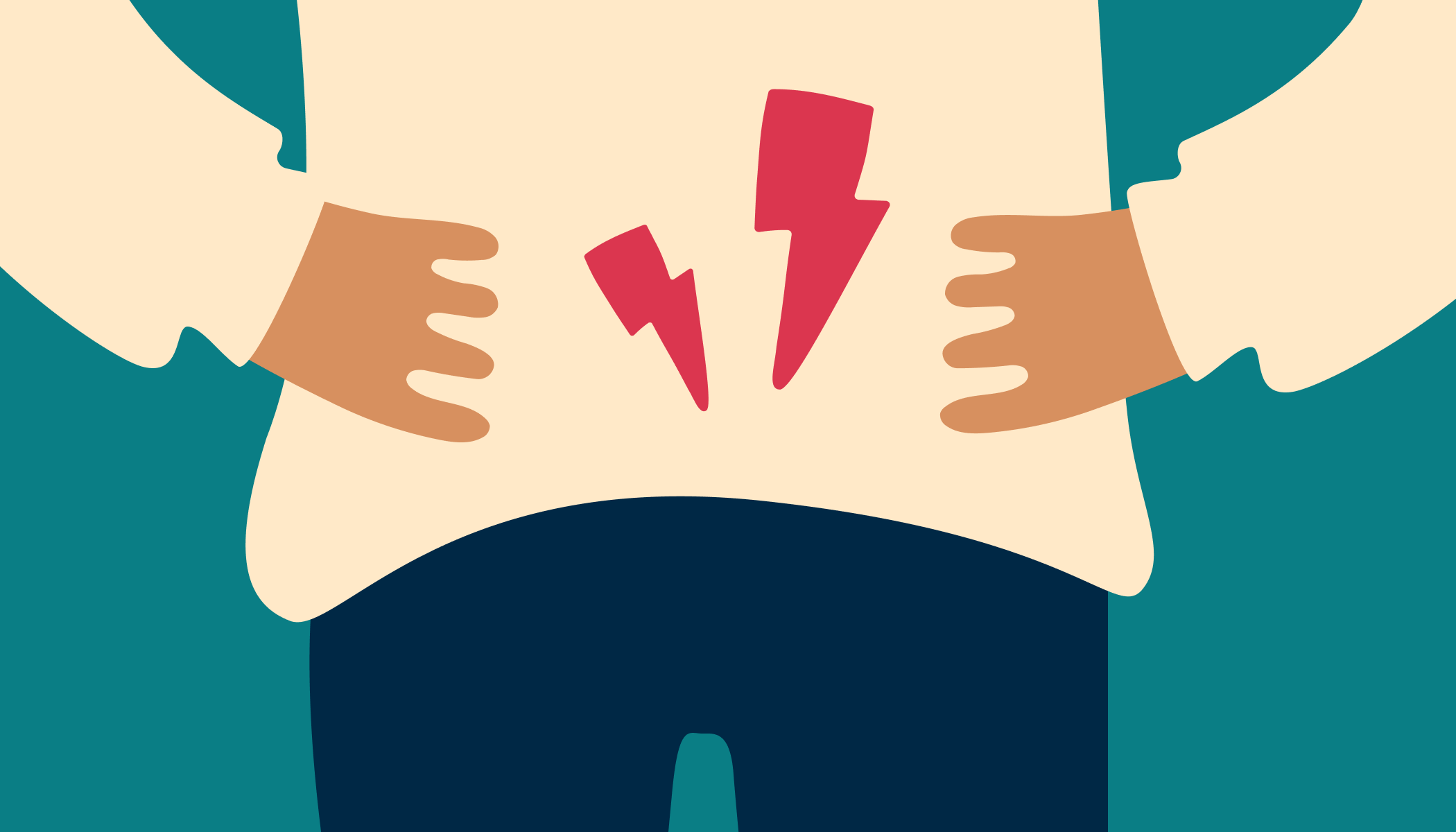Quick facts
- Most types of back pain have non-specific causes, like poor posture
- Taking quick movement breaks once every hour is helpful for back health
- Exercise like pilates can prevent back pain by strengthening the muscles that support your spine
Back pain can have a major impact on your life, making it harder to sleep, do the things you enjoy and for some, even sit down and stand up again. But it’s incredibly common, affecting an estimated 540 million people worldwide. And now, with more people confined to their homes, working remotely, and being increasingly sedentary, this figure may rise.
But back pain is not inevitable and there are many things you can do to not only help to prevent it, but also to alleviate it when it happens. Read our guide based on the best clinical evidence on how to cope with lower back pain.
Most types of lower back pain have no obvious cause (known as non-specific or NSLBP), or they’re mechanical, where the pain originates from the joints, bones, or soft tissues around the spine.
This type of pain...
- May be the result of poor posture, or lifting something awkwardly
- Can develop suddenly or come on gradually
- Usually gets better within a few weeks — 50% of sufferers recover within 2 weeks without treatment
- Often feels worse when you move, for example getting up from a chair
- May hurt more in certain positions and feel better if you’re sitting or lying down
- May be caused by a minor injury like a sprain (pulled ligament) or strain (pulled muscle)
- May feel worse if you’re feeling stressed or run down. ‘Stress may make back pain worse,’ says Dr Rhianna McClymont, Livi Lead GP ‘Particularly, if stress causes you to tense your muscles, hunch, adopt poor posture, or forgo activities that would normally improve back pain, like regular exercise’
Less frequently, lower back pain may be caused by an underlying medical condition like a slipped disc or sciatica (characterised by pain that runs from the lower back to the feet) but you will usually also have other symptoms, like numbness, weakness or tingling. In these cases, your doctor will refer you for specialist treatment.
What’s the best way to treat lower back pain when it strikes?
For non-specific pain, taking non-steroidal anti-inflammatory (NSAIDS) medication (like ibuprofen) can help to ease pain, but these should be taken for the shortest period of time. Always check the label, as NSAIDS may not be suitable for everyone. Paracetamol on its own is not recommended for back pain, but is usually taken in combination with a stronger painkiller like codeine. A doctor can also prescribe muscle relaxants for painful muscle spasms.
Should I use ice or heat?
Both heat and ice can help in different circumstances. Here’s a quick guide:
- Use ice if your pain occurs as a result of a direct injury, for example, after a fall, knock, sprain, or strain. Apply an ice pack for 10 minutes several times during the day. The cold lowers body temperature and helps to constrict blood vessels, reduce swelling, and inflammation. Cold will also help to reduce muscle soreness. But don’t apply ice directly to the skin as this can cause an ice burn, instead always wrap in a cloth or towel
- Use heat if your pain is more ongoing (and there’s no inflammation). Taking a hot bath or placing a hot water bottle on the affected area can often help
- Use a combination of ice and heat to help manage your pain. For example, use heat to warm up stiff muscles in the morning or before you go to bed and apply an ice pack for pain, where there’s inflammation through exertion, during the day. The cold will help to reduce inflammation and the heat aids in tissue healing
Is it better to move or stay as still as possible when I have an attack?
It may seem counterintuitive, but it’s important to keep moving and continue with normal activities as much as possible if you’ve got a bad back.
A recent meta-analysis showed that if you’ve got non-specific lower back pain (NSLBP), long periods of inactivity can have an adverse effect on recovery. The review showed that regular moderate aerobic exercise like walking and swimming, as well as strengthening and stretching exercises, can all reduce non-specific chronic lower back pain by over half.
But while it’s important to have some movement, it’s best to wait for any swelling to subside in acute cases before doing any exercise.
6 changes to help with lower back pain
If you get recurrent bouts of lower back pain, these simple lifestyle recommendations can help you manage and prevent them in the longer-term.
1. Stay as active as you can each day
A recent study shows that leading a largely sedentary lifestyle significantly raises the risk of lower back pain. Staying active can be as simple as doing some stretches or other gentle activity as often as you can throughout the day. For example, if you work at a desk, take a 10-15 minute activity break every 45 minutes. ’Taking breaks from work to walk and stretch and getting plenty of regular exercise is important for back care,’ says Dr McClymont.
2. Practice good posture
If you’re working from home, make sure you have an ergonomic workstation. ‘A suitably-sized desk and chair and correct keyboard position is important to help prevent back pain,’ says Dr McClymont. This includes sitting in a proper chair that supports your back, feet flat on the floor with your knees slightly lower than your hips and your shoulders relaxed. Your screen should be at eye level, with the monitor about an arm’s length away.
3. Do regular back exercises and stretches
‘Strengthening exercises like yoga or pilates are particularly good for back pain,’ says Dr McClymont. In a recent review, patients with chronic lower back pain showed significant improvement in pain relief after doing pilates 4 times a week for 6 weeks. One of the key principles of pilates is to work on strengthening your core muscles which support the spine, as weak core muscles can make you more susceptible to lower back pain.
4. Use correct lifting technique
When lifting objects, avoiding bending your spine. Instead, slightly bend at the hips and knees, keeping your core muscles strong. Hold the object close to your body and avoid twisting your back or leaning it sideways. Keep your shoulders level and facing the same direction as your hips. Try to move smoothly and know your limits.
5. Maintain a healthy weight
The more weight you carry, the more pressure on your back — two recent clinical research reviews showed that being overweight or obese increased the risk of developing lower back pain. If you’re finding it a struggle to keep to a healthy weight, ask your doctor for advice and treatment options.
6. Get enough sleep
Poor sleep can increase your perception of pain, while sleeping well can make pain seem less severe, a recent study showed. If you’ve been having trouble sleeping for two weeks or more, talk to your doctor about treatment options available, like a course of Cognitive Behavioural Therapy (CBT). Read more about how to sleep better in a pandemic.
When should I see a doctor?
If you have any of the following, talk to a doctor:
- A new and persistent back pain that doesn’t start to improve within a few weeks
- Back pain that is getting consistently worse with time
- Severe pain that is limiting your daily activities
‘Your doctor will examine you and decide on further investigations,’ says Dr McClymont. ‘Depending on what your doctor suspects might be the underlying cause of your pain, this might include a referral to a physiotherapist, an X-ray of your back or a more detailed scan like an MRI. Your doctor can also prescribe the appropriate pain medication, if over-the-counter painkillers aren’t enough.’
When to seek urgent medical attention
Occasionally, back pain can be a sign of something more serious and needs to be checked urgently. Get immediate medical advice at your nearest A&E department if your back pain is accompanied by any of the following symptoms:
- A sudden change to your bowels or bladder (like urine or faecal incontinence)
- Numbness in your legs or around your genitals or buttocks
- Weakness in your legs
Also, get immediate advice from your GP, from 111, or from A&E if you have back pain accompanied by:
- Chest pain
- A high temperature
- A swelling or deformity in your back
- It does not improve with resting or is worse at night
- Pain started after a serious accident
- Pain is so bad you’re having problems sleeping
- Pain gets worse when you sneeze, cough or open your bowels
- Pain is coming from the top of your back, between your shoulders, rather than your lower back



